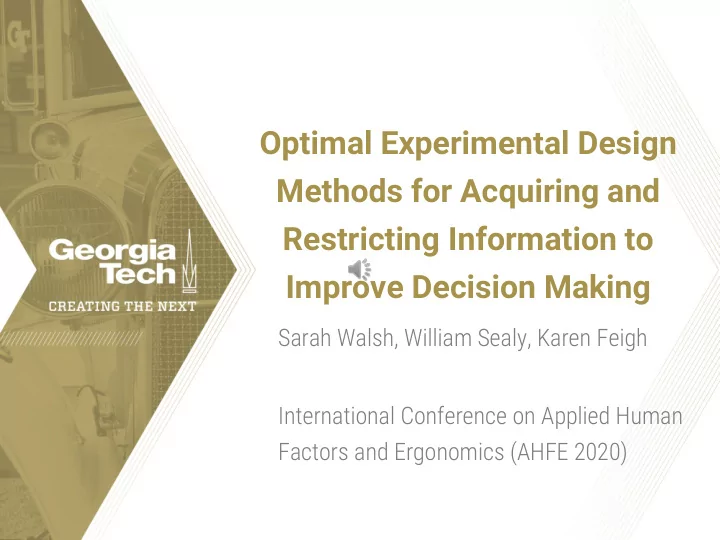

Optimal Experimental Design Methods for Acquiring and Restricting Information to Improve Decision Making Sarah Walsh, William Sealy, Karen Feigh International Conference on Applied Human Factors and Ergonomics (AHFE 2020)
2
Introduction • Decision makers are often required to make decisions with partial or incomplete information • To design effective decision support systems we must be able to pinpoint the most useful information to present to operators in order to increase decision- making accuracy • A crucial part of this task is assisting the decision maker in differentiating between their choices in one of two ways: 1. acquiring the most useful piece of information that is currently unavailable 2. restricting the available piece of information that is least useful in discriminating between options 3
Why restrict information: Less-is-more effect • Less-is-more effects: there is a point where more is not better, but harmful. Accuracy • There is an inverse U - shaped relation between level of accuracy and amount of information [3] Amount of Information How do we find the appropriate amount of information to 4 present to our decision maker?
How to curate information Information Information Acquisition Restriction Access the cues that are believed to be better predictors while intentionally hiding superfluous cues through usefulness measures 5
Foundational Work: Bayesian Optimal Experimental Design (OED) framework • OED framework gages the usefulness of experiments or parameters such that one can distinguish between options [7] • OED methods use Bayes Theorem for belief revision of each category when a new feature is observed then defines the usefulness of this feature • Usefulness [1]: 𝑣 𝑄𝐻 𝑔 = max 𝑄 𝑑 𝑗 𝑔 − max 𝑄 𝑑 𝑗 1 • f: new feature • c i: categories 6
Probability Gain for Information Acquisition • Information acquisition (IA): we aimed to find the usefulness of an unknown cue and acquire the most useful unknown cue • IA maximizes the probability gain, equivalent to minimizing the probability of error, and thus, maximizing the probability of making a correct decision [6] • Usefulness when adding a cue is given by: 𝑣 𝑄𝐻 𝑑 𝑗 = max 𝑄 𝑃 𝑘 𝑑 𝑗 , 𝐷 𝑘 − max 𝑄 𝑃 𝑘 |𝐷 𝑘 2 • O j : option category • C j : set of previously known cues • c i : new cue • *We use slightly different notation to be consistent with the exemplar 7
Probability Loss for Information Restriction • Information restriction (IR) looks at the usefulness of the cues already known and removes the cue that is least useful • IR seeks to minimize the loss in probability of removing a single cue • Usefulness when removing a cue is given by: 𝑣 𝑄𝑀 𝑑 𝑗 = min (𝑄 𝑃 𝑘 𝐷 𝑘 − max 𝑄 𝑃 𝑘 |𝐷 𝑘 , 𝑑 𝑗 ) 3 8
Predicting myocardial infarction (heart attack): Toy Problem Patient A Patient B Electrocardiogram (ST) Chest pain (CP) Other risk factors (OT) Infarction (Inf) 9
Predicting myocardial infarction (heart attack): Toy Problem Patient A Patient B Electrocardiogram (ST) Chest pain (CP) Other risk factors (OT) Infarction (Inf) 10
Predicting myocardial infarction (heart attack): Toy Problem 11
Conclusions 1. Decision support systems using OED probability gain methods can inform a decision maker on which information is most critical in acquiring to make their decisions and the level of criticality of that information 2. The new probability loss method has shown that we can limit the amount of information given to a decision maker and have almost no impact on whether one can computationally select the correct method 12
References 1. Baron J.: Rationality and intelligence. 1985. 2. Baron J, Hershey JC. Outcome bias in decision evaluation. Journal of personality and social psychology. 1988 Apr;54(4):569. 3. Gigerenzer, G., Gaissmaier, W.: Heuristic Decision Making. The Annual Review of Psychology, 62:451-82, 2011. 4. Canellas, M.C., Feigh K.M. Heuristic information acquisition and restriction rules for decision support. IEEE Transactions on Human-Machine Systems, 47(6):939 – 950, 2017. 5. Green, L., Mehr D.R.: What alters physicians’ decisions to admit to the coronary care unit? The Journal of Family Practice, 45:219 – 226, 1997. 6. Nelson, J.D.: Finding useful questions: On Bayesian diagnosticity, probability, impact, and information gain. The psychological review., 112(4):979 – 999, 2005. 7. Nelson JD. Towards a rational theory of human information acquisition. The probabilistic mind: Prospects for rational models of cognition. 2008:143-63. 8. Nelson, J.D., McKenzie, C.R.M., Cottrell, G.W., Sejnowski T.J.: Experience matters. Psychological science., 21(7):960 – 969, 2010. 13
Acknowledgements This work was supported by the Office of Naval Research Command Decision-making Program. The results do not reflect the official position of this agency. 14
Contact • For any questions contact Sarah Walsh sewalsh@gatech.edu or Karen Feigh karen.feigh@gatech.edu 15
Recommend
More recommend